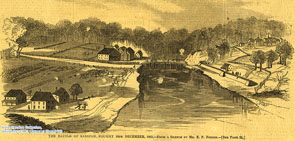Civil War Battles |
Colonial Wars |
American Wars |
Link To This Page — Contact Us —
The Battle of Kinston
December 14, 1862 in Kinston, North Carolina
 |
|||||||||||||||||||||
|
Books on The Battle of Kinston & the Goldsboro Expedition
are available from Amazon.com
The first battle of Kinston was part of a general troop movement by Union forces which extended as far west as Goldsboro, as far north as Fredericksburg, Va. and as far south as Wilmington. Union troops under the command of Brigadier General John G. Foster of New Hampshire had already taken the town of New Bern.
Foster's troops were estimated at 15 to 30,000 supported by nine small gun boats on the Neuse River. The Confederate forces, under the command of General George Evans of South Carolina, were estimated by contemporary newspaper accounts at 46 some less than 3,000 to more than 6,000 men." Evans, like Foster, was a West Point Military Academy graduate. On Dec. 10, 1862 the advance of Union troops on Kinston had begun. Newspaper accounts of the day present a vivid picture of the battle that ensued. Raleigh State Journal Dec. 12: "A courier just arrived from the picket lines brings a dispatch from Major Nethercutt, saying that he is pressed by the enemy and is falling back towards Kinston. The abolitionists are advancing in large force.
Report says the number is 17,000. It is reported Major Nethercutt lost 8 men on yesterday evening, killed and captured. A dispatch received in this, city this morning states that the abolitionists have attacked General Evans in force somewhere below Kinston. " The Raleigh Progress Dec. 13: "The enemy are advancing on the South side of the Neuse River. Fight progressing at half past 11. The enemy are within four miles of Kinston. The cannon adding is distinctly heard here and is very rapid. The result is unknown. " The cannonading reported in this newspaper account was probably the result of a hurriedly laid trap to halt the advance of Union gunboats up the river. The Confederates had constructed a series of obstructions in the river using stone and other materials to form jetties blocking the shallow river from passage by the gunboats.
Trapped, the gunboats were shelled by the Confederates as they tried to blast their way through the obstructions. Unfortunately for the Confederates, the only cannonballs they possessed were of the round solid type which bounced off the heavy armor of the Union ships. However, the diversion can be called a success as the Union boats were unable to advance up the river and shell the town as was intended in their battle plan. The State Journal Dec. 15: "On Sunday, December 14, the Union gunboats continued to batter away at the obstructions in the river as Union troops advanced along the South Shore of the Neuse. Gallantly the confederates was very hard fighting We numbered less than 3,000 in the fight-the enemy at the lowest estimate 20,000. The battle commenced about nine o'clock and ended about 5 p. m. Our men fought with great spirit and not until they were flanked on both sides did they retreat. The only open road left was over the bridge and after a portion had passed, an attempt was made to fire the bridge, but it failed, and the enemy succeeded in crossing under heavy fire of our artillery. We had 20 guns bearing down on the enemy, of which we lost three. Several of our men were burned and drowned in the attempts to destroy the bridge. A number of our men were cut off from crossing, and it is thought were taken prisoners supposed to be some hundreds, but it is doubtful as to the numbers. Evans forces retreated to Falling Creek, six miles north of Kinston as the Union Army marched into town. The remaining forces consisted of six regiments and six pieces of artillery. Evans hoped to receive reinforcements at Falling Creek and soon drive Foster's raiders from the town.
Fortunately, for Kinston at least, the Union Forces pushed on to Goldsboro, and Kinston was spared an attack by its own troops.
